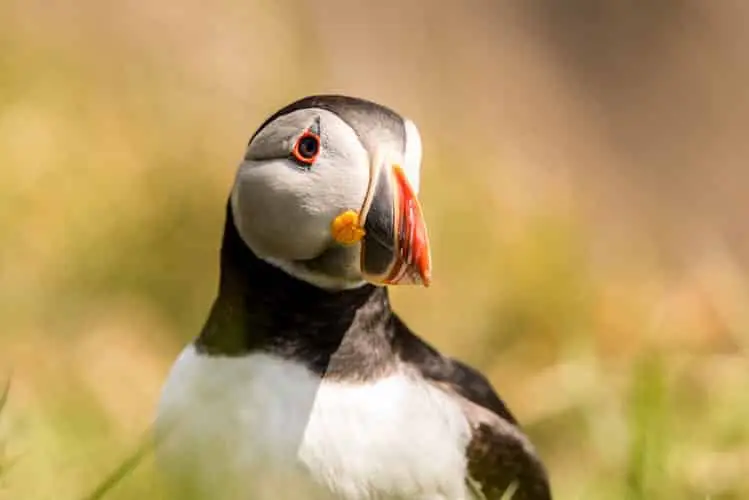Welcome to Animals and Wildlife in Alaska.
The natural life in this state is diverse and plentiful of animals in Alaska, and it has the most habitat for various animals like fish, birds, reptiles, and mammals.
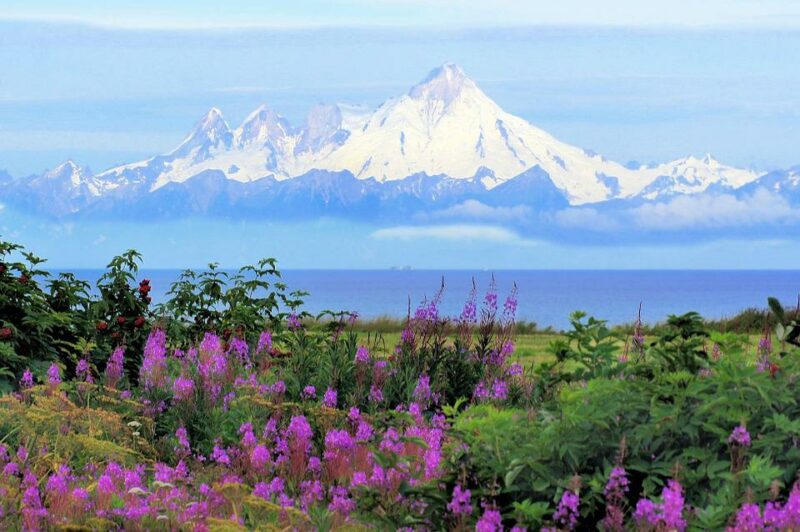
At the top, it has Born in the food chain, and Alaska has 70% of the Brown bear population covering most of North America.
Click below to jump to a section on Animals in Alaska:
Wildlife in Alaska
Alaska is considered the most significant state along all 50 states of the USA, positioned on the northwest border of Canada. Due to its closeness to the North Pole, there is no sunlight for approximately two months in the winter, and during the summer, there is no sunset for the same region, and it’s for almost three months. Alaska’s climate is often tiered among subarctic and tundra.
In the northernmost part of Alaska, there are 112 species of mammals, numerous species of big and small rodents, 530 types of birds, and many other forms of curious and amazing wild animals. Along with the water coast of Alaska, there are three different shark species.
Alaska has around 1100 vertebrate species, called the Home of those species. Many of these are wild animals, and some are endangered.
Grizzly Bear
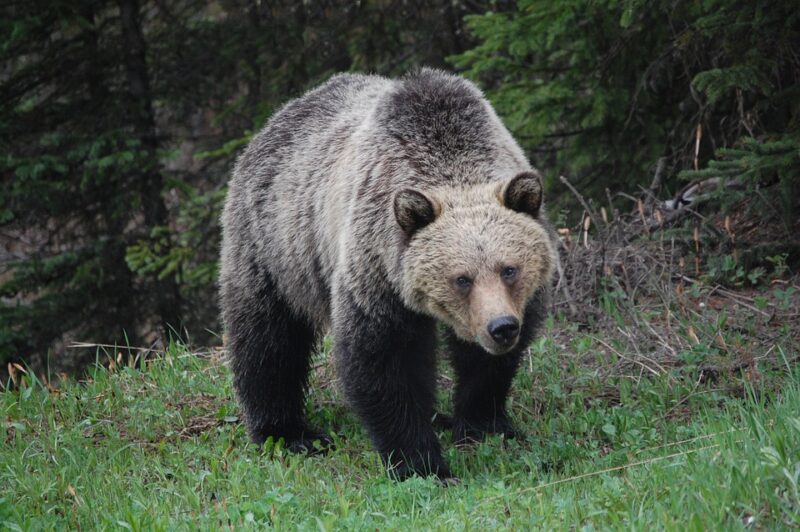
Grizzly Bear is also known as a kind of brown bear. Various people in North America use “grizzly bear” for the small and light-colored bears found in the inner regions of Alaska; the term “brown bear” is used for more extensive and dark-colored bears found in the Coastal areas of Alaska. Nowadays, most of these bears are taken as identical subspecies.
Grizzly bears are big and light tan (almost white) to dark Brown. They are short, round ears, dish face, and a big shoulder hump. The big shoulder hump helps the grizzly bear’s backbone, as the muscle mass is attached, which directly gives them support for digging and fetching their food. They have very long claws on their front feet, providing them the more significant potential to dig their meals and dens.
They are 700 pounds (315 kilograms), and the males are heavier than the females and might weigh up to 1700 pounds (770 kilograms). Female bears can weigh up to 800 pounds (360 kilograms).
A place where we can find Grizzly bears:
Grizzly bears are found in the various islands of Alaska, like South of Frederick (it’s part of Southeast Alaska), West of Unimak in the Aleutian Chain, and the Bering Sea Island of Alaska.
They are also found in Katmai National Park and Preserve, a remote area in Southern Alaska. They mainly cover regions of North America from the central plains to California along with Central Mexico (north part) throughout Alaska and Canada alongside other animals in Alaska.
Dall Sheep
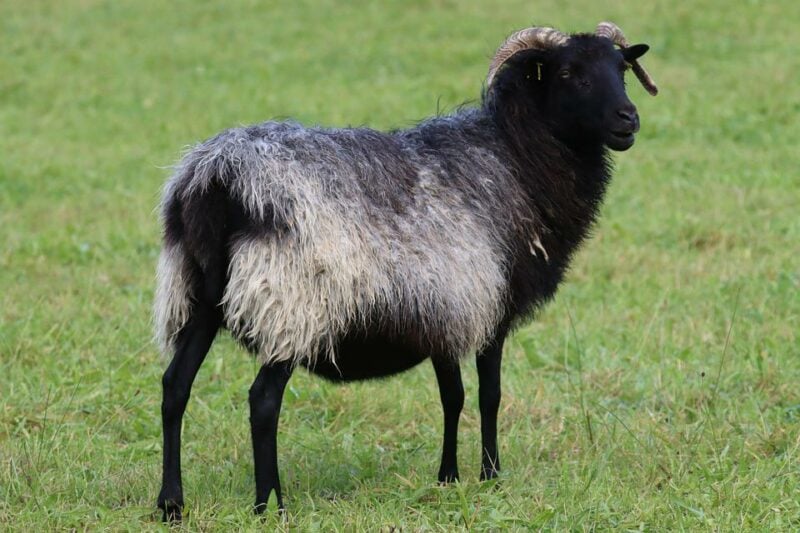
Dall Sheep, also known as Thin-horn Sheep, is a Wild Sheep found in the mountain levels of Alaska. These white creatures are recognized mainly by their big curled horn and are generally categorized as males.
Female Sheep, generally called ewes, have additional horns. However, their horns are shorter, greater narrow, and best slightly curved. At the age of three, Sheep resemble the same as female sheep, so there is significantly less difference till the age of three. After three years of age horns of males and Sheep start growing, which helps to recognize them easily.
Horns grow slowly at some stage in spring, summer, and early fall. During the winter season or late fall, horns growth slowdown or even stops. This start and stop of horns results in a pattern of rings, also known as annuli, which w, which help in finding the age of the Sheep. Male Dall sheep can live up to 16 years of age, and female dall can reach up to 19 years of age, but mostly 12 years old Sheep are considered old sheep.
The place where we can find all Sheep:
Dall sheep are primarily found in the mountain ranges of Alaska, like the subarctic and arctic mountain ranges. They are found in the Yukon Territory, the Mackenzie Mountains in Northwest Territories, and central & northern British Columbia. They are found in ground areas, too, like alpine tundra, meadows, and rugged surfaces.
They are found in the Kenai Mountains, tok area,Wrangell mountains, delta controlled, north side of the Alaska Range (Nenana river), south Tanana river, and hills.
Musk Ox
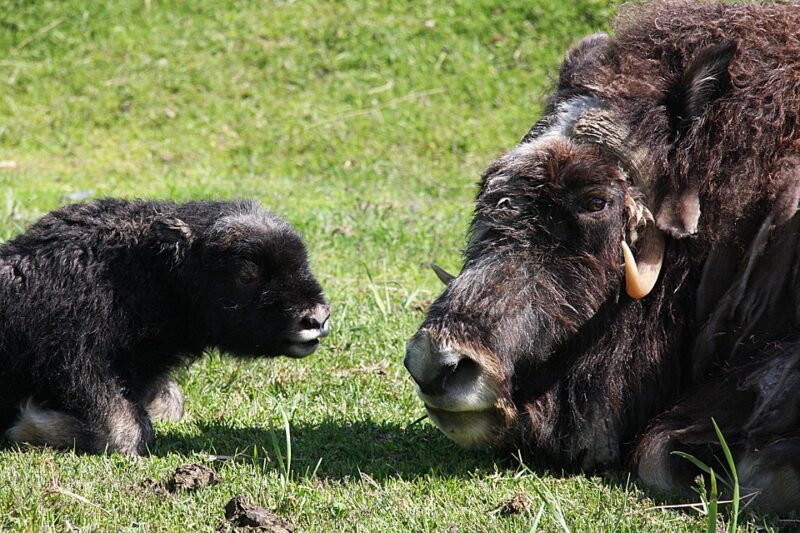
Musk Ox are categorized as mammals. They have large heads, short legs, along with short necks. They are named Musk Ox because of the musky smell of these mammals and their similar resemblance to Ox; they are not linked with cattle. Musk Ox is considered a subfamily of Caprinae. The Caprinae family has goats and sheep as their members, so the musk ox is related to mountain goats, chamois, and serow.
Musk Ox is found in both north and south part of Alaska. Ox, located in the north, is smaller than in the south region. Both males and females have h, orns and the old male has 60 cm long horns (24 inches). Male and female musk ox has the same structure for horns. They have a broad base, deep down from the sides of the head, and curved shapes from the upward end.
Young ox and females have the same horn but are small. Old Musk ox has long hair, which is dark brown, and touches their feet. Hairs cover the ears of musk ox and hide the tiny tail; they have short hairs on their face, which surrounds them. They have hairy costs, which help them in summer, and are generally called qiviut.
They travel in groups of generally 20-30 members. They are not aggressive, but if another animal attacks the adult, they will use their horn to protect themselves and another young ox in the group. Sometimes, this defensive nature will make humans think that they are aggressive. They usually eat grass, sedges, and willows. In the summer, they carry a large amount of fa,t which helps them in the winter and as a supplement.
A place where we can find Musk Ox:
They are found in Northcentral, northeastern and northwestern parts and other animals in Alaska.
They are also found in Nunival Island, Nelson Island, The Seward Peninsula, The Yukon Kusjokwin Delta, and in local regions of Alaska.
Caribou
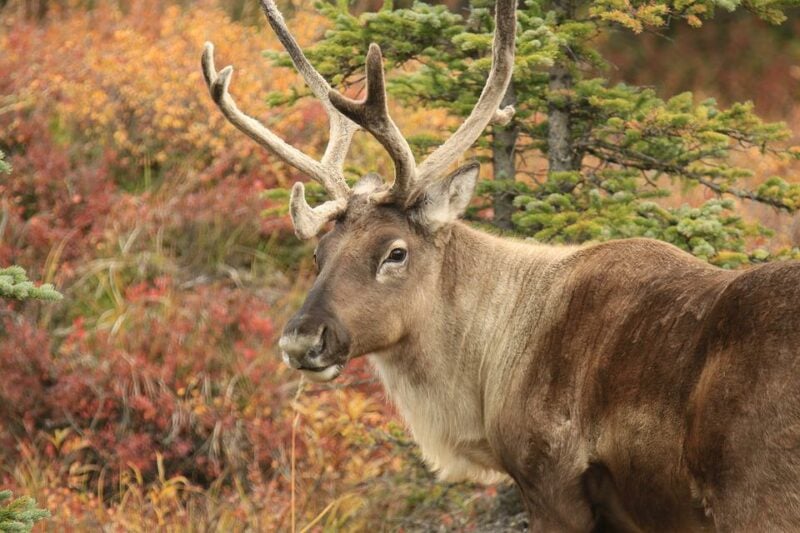
Caribou has an estimated population of approx. 750000, with 32 caribou groups present in the Alaska region. As the weather changes in Alaska, this might affect the migration of Caribou from one place to another.
They move from different forest locations in winter, like Boreal forest areas, to open or coastal tundra regions in the spring season for calving. During migration, they cover around 50 miles in a day. Caribou can use these migration routes for many years, but there may be sudden route changes as to food availability. Many locals survive on caribou for their livelihood. Caribou have a large feet, which helps them in snow and soft regions. They also use their feet as paddles while swimming.
In the winter, Caribou are brown with white necks, feet, and spines. The newborn calves have dark chocolate brown sometimes, and they will be reddish brown hair too. Adult caribou have an average weight of 350 -400 pounds, and females have an average weight of 175-225 pounds. The newborn caribou has an average weight of 13 pounds, increasing; they may get double in 10-15 days.
A place where you can find Caribou in Alaska:
They are found in Denali National Park, north of the Alaska region. Many small caribou roam in the Kenai Peninsula region of Alaska, located on Steese Highway, the North of Fairbanks in Alaska. In the winter, they herd towards the Boreal forest (taiga), so they can also be found in this region.
Wolves
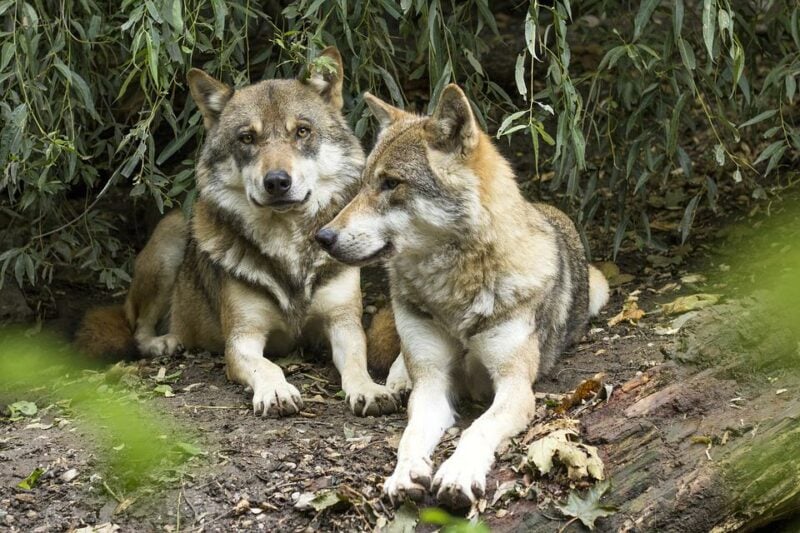
Animals in Alaska: Wolves are majorly found in Alaska, and one can quickly discover wolves in around 85 percent of the areas in Alaska. They mainly cover areas like Unimak Island in Aleutians and some islands in Southeast Admiralty, Baranof, and Chichagof.
These regions cover approx—586000 square miles of area. Wolves are sometimes considered social animals, and they usually live in groups known as packs. These groups have parents and pups of the year, and some large groups have more dogs and more than one female member in their group.
Wolves can be aggressive, too, while living in groups because of specific behavior or situation, so one should take care of it. In Alaska, a large population of gray wolves is found in the United States. Mainly there are two common subspecies of wolves found in Alsaks: black to nearly white and grey or black.
A male wolf has an average weight of approx. 85-115 pounds, and female wolves have an average weight of 5-10pounds or may reach 110 pounds. A wolf plays a vital role in managing Alaska’s ecosystem and helps in ‘Alaska’s tourism economy. Many travelers around the world came to see the natural habitat of wolves.
A place where you can find Wolves in Alaska:
They mainly cover areas like Unimak Island in Aleutians, some islands in Southeast Admiralty, Baranof, and Chichagof Islands, and other animals in Alaska.
Flying Squirrel
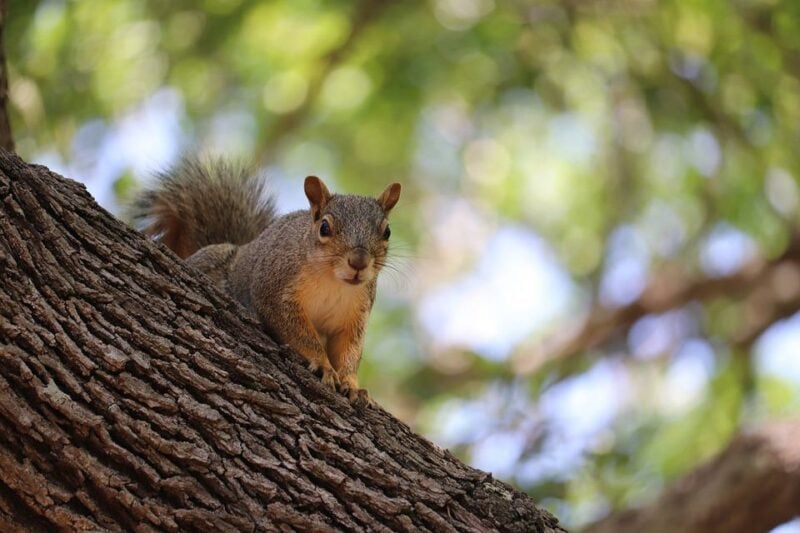
The flying squirrel is one of the animals in Alaska which flies in nature but cannot fly like a bird or bat in the sky, so they glide, not fly. Around 25 subspecies of squirrels are found in North America and the Interior part of Alaska. They are primarily found in Alaska’s northern and western regions, mainly near streams and rivers. The adult flying squirrel has an average weight of 132 gm and 30cm in total length.
Flying squirrel mostly eats fungi of various other species and can also eat mushrooms, nuts, lichens, tree sap, insects, buds & flowers. These squirrels are also known as a cache of food when food supplies become low in seasons.
They generally store their food in tree cavities or their nest when there is a low food supply. They naturally created their nest in trees with large diameter trunks and dead trees. Nests can also be made in buildings and homes, and they typically shift from one perch to another nest when they are young.
A place where you can find Flying Squirrel in Alaska:
Flying squirrels are located in the eastern United States from Maine south to Florida and are also found west from Minnesota south to Texas. The second subspecies of flying squirrel is located in the Northeast region along the west coast and Idaho and Montana region.
Walrus
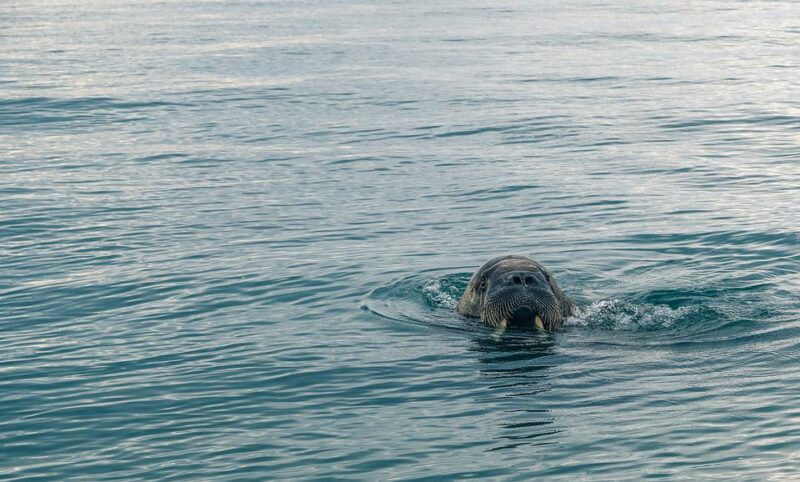
Walrus look like seals and sea lions, but some features differentiate these animals. One is their large size, and another one is the big tusks. These big tusks are found in both male and female adults.
Walrus are also named Odobenus, which means tooth-walker; this word also defines their characteristic. Often walrus use their tusks to climb on ice land and help in fighting, and tusks also help them save their calf from falling over ice. It is generally considered the animal with the enormous tusk dominating the others.
But walrus are loyal to their groups and will not leave each other quickly. Male adult walruses have an average weight of 4000 pounds, making them one of the largest aquatic animals. Due to their large size, they are harmless but can be noisy, so one should take care of them. Many local Alaska natives survive on walrus for their livelihood.
A place where you can find Walrus in Alaska:
There are two species of walrus, one is the Pacific, and the other is the Atlantic. The pacific is found in Bering and Chukchi Seas from Bristol Bay in Southwest Alaska (point barrow in the Far North). They generally see in the summer season but can be seen throughout the year.
Sea Otter
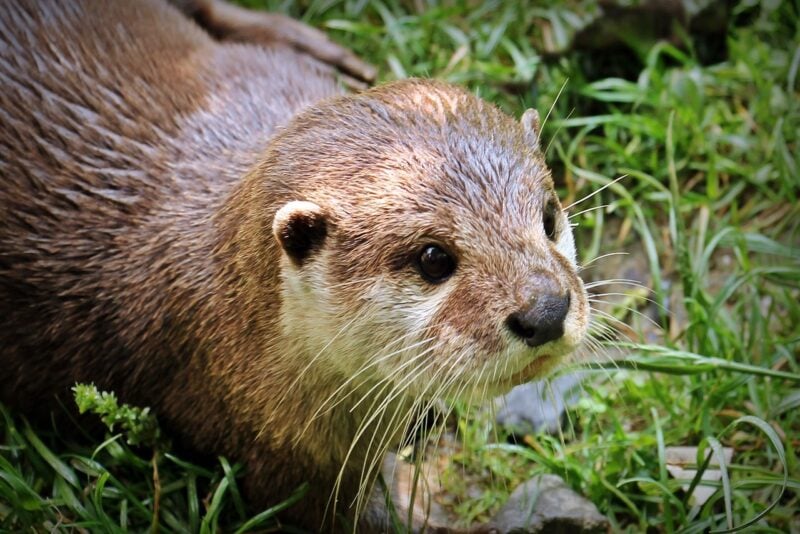
Sea Otter is considered the most prominent member of the weasel family. They are colored brown to black and have dense fur and long hairs that protect them. The guard’s hair color may vary from brown–black – to silver.
For these animals in Alaska, their back feet help them in swimming, and their forefeet are short and stiff in size. Adult sea otters can grow up to 5 feet in length. The male sea otter weighs 80-100 pounds and can be over 100 pounds. The female sea otter is smaller and has an average weight of 50-70 pounds.
They are mainly hunted for their fur. Sea otters generally survive on marine food diets of fish, mussels, abalone, sea urchins, worms, and snails. They are good swimmers who can spend most of their time underwater and occasionally come on land to rest.
A place where you can find Walrus in Alaska:
They can be found in many Alaska places, like Aleutian Island, Southern Alaska, British Columbia, and Washington. In Alaska, they are found in Southeast stock from west of Glacier Bay to the eastern edge of Cook.
Puffins
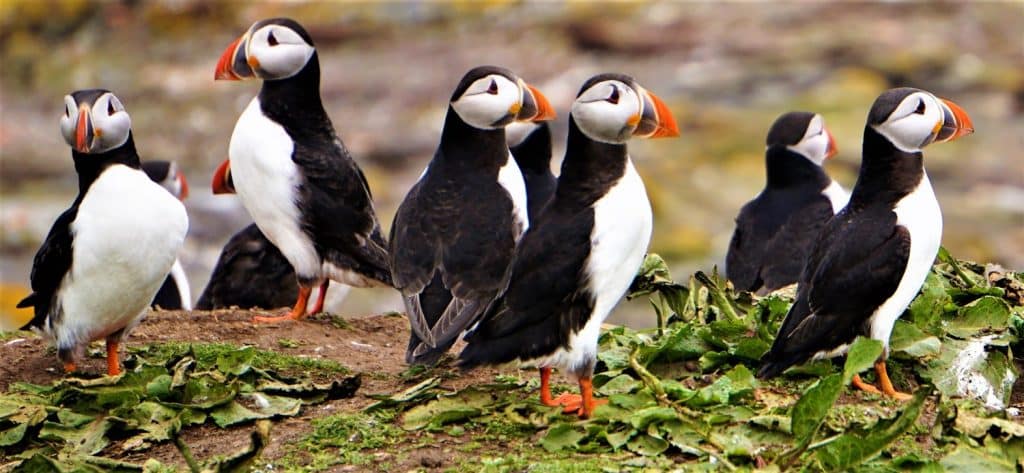
Puffins are the unique sea birds found in coastal Alaska. There are two species of Puffins, one is a tufted puffin, and another one is a horned puffin. The difference will be a bright orange beak and web kind of feed, which are black & white. In earlier times, sailors called them sea parrots because of their color.
Tufted puffins have golden tufts of feathers behind their eye, and horned puffin has black horn marking over both eyes, so their eye marks differentiate them. Their weight is approx. 1.5 pounds and the average wingspan is 25-30 inches. Puffins can swim water; they are good swimmers. They are made for swimming rather than flying. Many tourist visits to see them in different locations in Alaska.
A place where you can find Puffins in Alaska:
They are found in Southeast, southwest, and south-central Alaska. They can mainly find on wildlife cruises or trips toward coastal areas of Alaska.
Puffins can find in September, and they mostly spend their winter at the seaside in the North Pacific Ocean.
Summary of Animals and Wildlife in Alaska
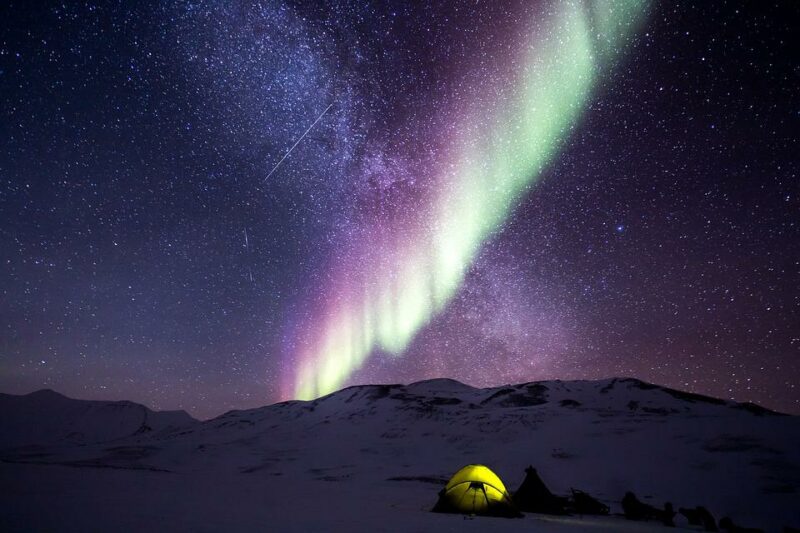
Animals in Alaska play a vital role in managing the ecosystem. One can find a plentiful animal in Alaskaion, predominantly brown bears. There are approx—One hundred twelve species of mammals, along with 530 kinds of birds. There are 1000 vertebrate species in the Alaska region, like grey wolves, fishes, red foxes, musk oxen, etc.
Due to its closeness to the North Pole, there is no sunlight for approximately two months in the winter, and during the summer, there is no sunset for the same region, and it’s for almost three months. There are several parks found in Alaska, like Denali National Park, Kenai Fjords National Park, Kobuk Valley National park, Glacier Bay National Park, and many others, where we can find many species of animals.
Did you enjoy this article about the wild and beautiful animals in Alaska? Look at our blogs featuring Arkansas and New York‘s natural attractions.
- 10 Most Endangered Animals - April 15, 2024
- Top 10 Cutest Fish in the World - April 15, 2024
- 16 Top Predators in the Food Chain - April 12, 2024

